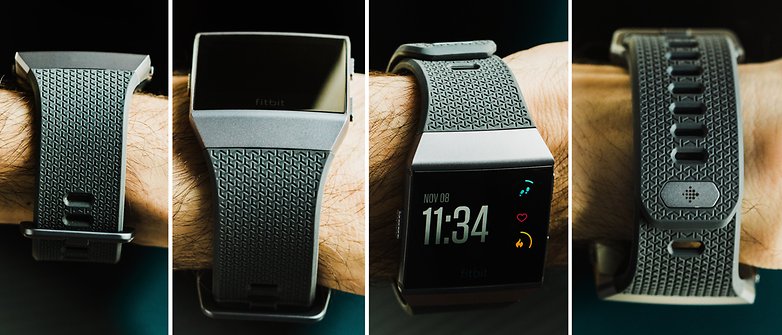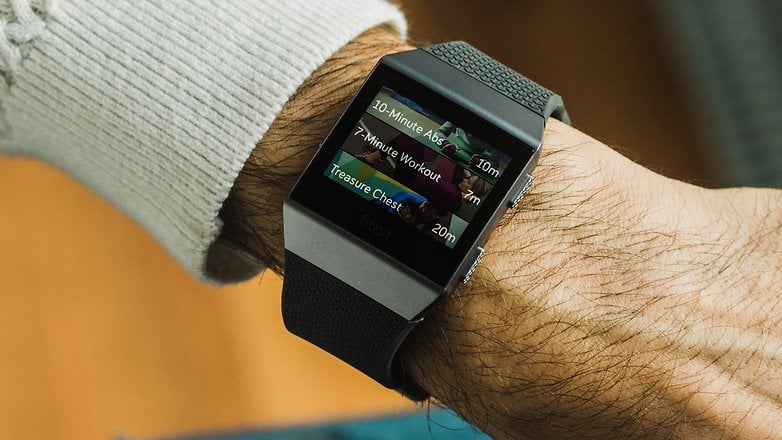Fitbit Ionic review: The sporty smartwatch


Fitbit, undisputed star of fitness trackers, has decided to step out of its comfort zone. For the first time, the US manufacturer wants to compete with the Apple Watch and Android Wear smartwatches. The Fitbit Ionic is the first smartwatch from the company able to take advantage of apps developed by third parties. After several weeks of testing, here are my impressions.
Release date and price
Made official at IFA 2017, the Fitbit Ionic is available for $299. Fitbit's connected smartwatch comes in three colors: Blue Gray/Silver Gray, Slate Blue/Burnt Orange and Charcoal/Smoke Gray.
Design and build quality
As far as I can tell, the Fitbit Ionic is not the best looking smartwatch on the market. The Ionic follows the tradition of the Blaze with its square dial. In everyday life, it goes rather unnoticed, so it should be fine for a wide range of people. However, those concerned with fashion will opt for another model, since the Ionic is missing a bit of sex appeal due to its rather thick borders around the dial. The watch is comfortable to wear and is easily forgotten despite its weight of 46 grams.

On the technical side, the Ionic's casing is made of Series 6000 aluminum, an alloy of magnesium and silicon identical to the iPhone 6, which showed signs of weakness soon after its launch. Apple has opted for aluminum 7000 series for its iPhone 6s and iPhone 7 because it contains zinc, which guarantees more strength. I remain, for example, quite pessimistic about the Fitbit Ionic resistance to scratching. Regarding the build quality and finish, however, everything looks and feels right.

The strap supplied in the box is made of silicone. For sports, it's very practical. Its fastening system (a buckle and an attachment button) is invaluable to avoid any risk of loss. It is sometimes a little difficult to wrap around the wrist, the loop being so tight that the piece of elastomer on the bracelet has difficulty fastening. Fortunately, silicone seems to be able to withstand the test of time (and perspiration). Of course, the strap is proprietary so you'll have to go through the Fitbit store to get new ones (including leather). The changing the strap is, fortunately, very easy.

In the middle, of course, is the 1.4-inch screen of the Fitbit Ionic. There are three buttons on the sides (two on the right edge, one on the left edge). The one on the left is a back button, while the buttons on the right are for navigation. The top button displays the stats of your day, and the second is dedicated to kicking off exercise sessions. On the back, there is an optical heart rate sensor. I will return to the topic of its effectiveness later. The watch is waterproof, so swimming with it is definitely possible.
Display
The Fitbit Ionic features a 1.42-inch LCD touch screen, with a resolution of 348 x 250 pixels and a pixel density of 302 pixels per inch. Just like the Gear Fit2 Pro we tested recently, the watch is covered with Gorilla Glass 3 for extra durability.
Compared to Samsung's smart fitness band, the display of the Ionic does not offer as much contrast, but the watch's display is still very good. The Fitbit Ionic features bright colors and high brightness (1000 nits like the Apple Watch 2). The readability is very good, and the Fitbit Ionic is a perfect companion for any type of sporting activity. I was pleasantly surprised by its usability underwater, especially in terms of readability.
As for responsiveness, it's not bad. However, the screen is sometimes a bit slow to respond and you have to make an effort to move your wrist enough to wake the screen. This is annoying from time to time when you are doing an activity and want to know information quickly.

Special features
Fitness features
In addition to its smartwatch capabilities, the Fitbit Ionic is of course a perfect tool for tracking your sports activities. All the fitness features we know and love from other Fitbit products can be found here:
- Pedometer: The Ionic translates motion sensor data to count your steps. Active days will result in a large number of steps, and inactive days, a small number. As always with Fitbit, the result is rather optimistic.
- Sleep monitoring: The watch automatically detects the hours between when the user falls asleep and wakes up. The app also tells you about your sleep cycles: in-between, light, deep. Personally, I appreciated this information since it allows me to predict fatigue. You just have to get used to sleeping while wearing this watch all the time, which could be painful or uncomfortable for some people.
- Nutritional monitoring: It's possible to manually monitor your diet in the app. However, you must always enter the information about your meals yourself, which requires a certain commitment.
- Caloric expenditure
- Activity tracking: running, cycling, swimming, treadmill, bodybuilding, etc.
Although I still had some initial apprehension during my underwater sessions, the Fitbit Ionic has been able to withstand swimming. Sometimes the results can be distorted when counting distance for laps in the pool.

Fitbit Coach
If Fitbit presents its smartwatch as a fitness coaching watch. Through videos shown on the watch, you'll be guided through workouts. For the moment, only three videos are available. More free videos should arrive later. The idea seems good, but sometimes it's difficult to follow the video on your wrist and move at the same time. Maybe a speaker would have helped here.

Fitbit also offers other custom exercises in the Fitbit Coach app. This is actually a new version of the Fitstar app, from a company bought by Fitbit. Custom exercises will be suggested to you, but there's a $39 annual subscription fee. These custom workouts will show you exactly what to do. Each exercise, you can leave comments to better adjust your workouts. The goal here is to help you improve and encourage you to try different types of exercises.

Software
The Fitbit Ionic runs on the manufacturer's own OS, Fitbit OS. Despite the marketing promises of the brand, I admit to being disappointed with the possibilities offered by the watch. If the purchase of Pebble for $40 million foreshadowed good things, its integration still leaves something to be desired. For the first time in its history, Fitbit offers a development kit (SDK) for third party developers to create their own apps for the watch. For the moment, though, the Fitbit App Gallery catalog is relatively empty. Apart from a few partner apps that are very strong (Strava, Starbucks and Pandora to name a few), there's not many other satisfying options. Fans of Spotify will, for example, have to transfer their songs to the 2.5 GB internal memory of the watch. It doesn't need to be so complicated.

Unable to respond to notifications
Fitbit OS allows you to receive notifications on your Ionic (calls, messages, social networking). The problem is that you don't have the opportunity to respond, which creates a great sense of frustration. It is only possible to clear the notifications, one by one or all at once. Why, Fitbit? The watch doesn't have a microphone or suggest replies.
Fitbit app
As always, the Fitbit app is one of the best features. It's always so intuitive and fun to use. The app displays the essential information on the home page as blocks which you can rearrange as you wish. You can easily find all activities completed and you can challenge your friends. It is compatible with a large number of third-party services (Alexa, IFTT, MyFitness Pal and more).
There's nothing to say about the synchronization between the smartwatch and the app. It's quick and painless. The only problem I encountered was during the initial configuration, since it took more than two hours to download and install the mandatory update to use the device.

Performance
As far as tech specs go, the Fitbit Ionic has 2.5 GB of internal storage, which can be used to store your music for example. There's an NFC chip for payments, a GPS, an optical heart rate sensor, a gyroscope, a barometer and an accelerometer to measure all of your physical activities.
In general, the performance is good and the resource management seems to be under control. However, as explained above, I've experienced some delays, though I'm not sure whether it's because of the processor or the system itself.

GPS and heart rate monitoring
The GPS performed well and the distances proved to be accurate and consistent with what my smartphone recorded. Regarding the optical heart rate sensor, I found the results slightly higher than reality, even though Fitbit explained that its new algorithms made the measurement more accurate. While the results are more stable, the recordings still seems a little high. If your wrists are heavily involved in your sporting activities, the heart rate results are basically useless. Of course, as for other fitness trackers, we must remain cautious about the information received since these are always estimates. Once again, I encourage you to read the article written by my colleague Stefan on the topic:
- Optical heart rate sensors have got my pulse racing, and not in a good way
Battery
If you're looking for a long lasting smartwatch, the Fitbit Ionic will delight you, as battery life is one of the areas in which the watch excels. As promised by the manufacturer, the Ionic is able to hold out for nearly 4 days before showing severe signs of fatigue and requiring recharging. Rest assured, there is no need to disable the cardio sensor or limit the brightness to achieve such a result. It's a different story if you use the GPS a lot, as the range is greatly reduced. But there is nothing surprising about that.
It is difficult to competing smartwatches that are doing better in this area. The only negative point is the method of charging itself. As always, Fitbit offers a proprietary cable, so you'll want to take care not to lose it as it's a pain to replace. Fitbit offers only the charging cable and not the charger in its box. Given the price of the watch, we were entitled to at least that.

Final verdict
Was Fitbit's bet on the coaching watch successful? Not really, in my opinion. As a smartwatch, it's a little too limited. The system isn't very mature (it's not possible to reply to notifications!), and it lacks apps. The design is a bit too simple to really win me over.
Nevertheless, the Fitbit Ionic isn't a bad product. The watch is an ideal companion for sport tracking and it benefits from the brand's experience in this field. As ever, the Fitbit app is a great strength. You can use the device for many activities (running, swimming, bodybuilding) and its battery life is fantastic. But in the end, the price seems a bit too high for an activity tracker, and it's not advanced enough for a smartwatch when you compare it to the competition (Samsung Gear S3, Apple Watch and others).



















